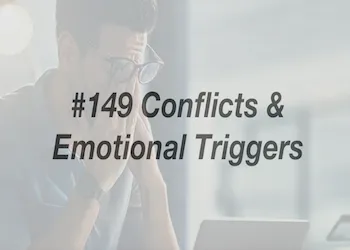MLMT 149: Conflict and Emotional Triggers
MLM Trigger Episode #149
We talked about “story selling” to get people excited about the new opportunities you offer them… Today let’s talk about how to structure and use these stories to create belief in the minds of your customers.
When you listen or read about Michael Hauge, “one of Hollywood’s top script consultants and story experts for more than 30 years,” you will really understand STORY STRUCTURE. Once you understand the structure, you are going to be able to craft stories with the right environments for people to have the necessary epiphanies. You will be on the path to follow the correct story structure for maximum emotional impact and change beliefs.
LISTEN ▶️ Conflict and Emotional Triggers
Good stories are really simple. There can be layers of complexity, but at the core they are all very simple. You can tell the same story in 60 seconds or 60 minutes—all with the same desired effect.
Every good story is built on three elements (Character, Desire and Conflict).
These are the basic elements of every movie, book, play, TV show, opera—any type of story.
Michael explained: Every good story is about a CAPTIVATING CHARACTER who is pursuing some compelling DESIRE and who faces seemingly insurmountable OBSTACLES to achieving it. That’s it… If you’ve got those three things, then you’ve got a good story.

Your first Bridge story you will tell… is the one that got you excited about your new opportunity in the first place. You are the character.
-What desire started you on your journey?
-What did you want to achieve?
-Then, what was the conflict you experienced along the way?
Now let’s hook your story into people’s emotions:
The first 10% of any story is all about building rapport with the hero, so we have an interest in their journey. If you do a good job of building that rapport up front, the audience will be engaged throughout the whole thing. Sharing flaws is critical in gaining rapport immediately. Sometimes it’s scary to share these flaws in your stories, but they are the key to building rapport.
You want to connect with these core identities:
• Make the character a victim of some outside force, so we want to root for them.
• Put the character in jeopardy, so we worry about them.
• Make the character likable, so we want to be with them.
• Make the character funny, so we connect with them.
• Make the character powerful, so we want to be like them.
Introduce the desire for something more. Every story is about a journey that drive most heroes either toward pleasure or away from pain.
• The hero may be trying to win the heart of someone they love, or trying to get fame, money, or prestige. They are really looking for an increase in status
• The hero wants to obtain something and bring it back
• The hero desires to get away from something that’s causing pain
• The hero wants to stop some bad thing from happening.
The story describes the journey to achieving the desire. But the hero is actually on two journeys—the one that everyone sees (The Journey of Achievement), and one that’s hidden (The Journey of Transformation). The second journey may not be as obvious, yet it’s the key to the whole story.
Desire is essential to the story because it shows the end goal. It provides a reason for the journey to move forward. But emotion doesn’t come from the desire. It comes from the conflict the hero faces while trying to gain the desire. Our primary goal as storytellers is to trigger emotion, and you can’t do that without conflict.
Look at almost every successful movie and you will see the pattern of the hero’s two journeys. Let’s look at the turning points that create the emotion in every movie, book, play or any type of story.
Turning point #1: After you share the character’s backstory, some event causes the character to physically leave where they are and start the journey. This new opportunity is what sets them off to achieve their desires.
Turning point #2: At some point, the original desire will transform into a very specific, visible goal with a clearly defined end point. This is where the hero’s outer motivation is revealed.
Turning point #3: This is when the hero must burn their old bridges and dive in with both feet and must fully commit to reaching the goal. There is no RETURN something happens here that makes this a DO-or-DIE situation. It’s no longer a SHOULD — it’s a MUST.
Turning point #4: Something happens to the hero, and we believe that all is lost with no chance of success. Then we see a small glimmer of light. He has only one option to take one last all-or-nothing shot at the desire.
Turning point #5: Now our hero must face the biggest obstacle of the entire story and determine their own fate. The journey of achievement will be resolved once and for all, and the journey of transformation will be revealed. Then the hero’s new life is revealed, and the journey is complete.
Your primary goal as a storyteller is to master this process that will serve you for the rest of your life in everything you do.
LISTEN ▶️ Conflict and Emotional Triggers
May you be wealthier,
--Corine-
The top producers in MLM don't make a list of 200 people, don't do home meetings or anything like that. They use something equivalent of a sales funnels.
